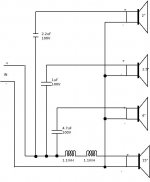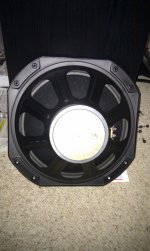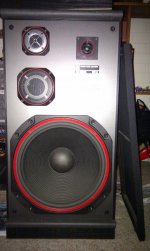Hi,
My boss' wife got sick of his speakers and so he was giving them away. Not to look a gift horse in the mouth I though i might take them off his hands as something to play with.
On first inspection they seemed reasonable enough. 4 way system with 15", 4", 2.5" and 2" drivers. The boxes were made by Peterson Speaker Laboratories. The specifications listed on the box are:
BD Series BD15
Freq Range: 35Hz - 20kHz
Sensitivity: 92dB
Power Handling Capacity: 250W
I got them home and the first thing I did was take the drivers out to have a look at what they were. In this process i noticed that the enclosure itself was made of chip board and not well braced. There was also with no baffling inside at all which I found surprising.
Anyway the point of all this is while the drivers are marked I suspect these are quite old (as in mid 1980's) and I have not been able to find any information on their specs. The markings are:
15”: BJD FH-1540, 8 Ohm, Taiwan
4”: BD TM-4001, 8 Ohm, Taiwan
2.5”: BD 66FT38A2, 8 Ohm, Taiwan
2”: BD A80A60DM-02HT, 8 Ohm, Taiwan
I was wondering what the best approach is to characterising these drivers. My key concern is the individual power rating. Is there a sensible way to reverse engineer a safe operating level from the overall 250W number above? Has anyone an idea on how to approach this?
I welcome any advice you can provide.
Thanks
Kujo
My boss' wife got sick of his speakers and so he was giving them away. Not to look a gift horse in the mouth I though i might take them off his hands as something to play with.
On first inspection they seemed reasonable enough. 4 way system with 15", 4", 2.5" and 2" drivers. The boxes were made by Peterson Speaker Laboratories. The specifications listed on the box are:
BD Series BD15
Freq Range: 35Hz - 20kHz
Sensitivity: 92dB
Power Handling Capacity: 250W
I got them home and the first thing I did was take the drivers out to have a look at what they were. In this process i noticed that the enclosure itself was made of chip board and not well braced. There was also with no baffling inside at all which I found surprising.
Anyway the point of all this is while the drivers are marked I suspect these are quite old (as in mid 1980's) and I have not been able to find any information on their specs. The markings are:
15”: BJD FH-1540, 8 Ohm, Taiwan
4”: BD TM-4001, 8 Ohm, Taiwan
2.5”: BD 66FT38A2, 8 Ohm, Taiwan
2”: BD A80A60DM-02HT, 8 Ohm, Taiwan
I was wondering what the best approach is to characterising these drivers. My key concern is the individual power rating. Is there a sensible way to reverse engineer a safe operating level from the overall 250W number above? Has anyone an idea on how to approach this?
I welcome any advice you can provide.
Thanks
Kujo
Hi !
Did you listen to the speaker ? What do you think ?
Some photo will talk more to us ...
The Box is Bass Reflex ? if yes I think the baffling is not important.
You can buy a cup for the 4"
Bracing the box and add damping could be a good improvement.
Could you do a schematic of the crossover ?
Cheers.
Did you listen to the speaker ? What do you think ?
Some photo will talk more to us ...
The Box is Bass Reflex ? if yes I think the baffling is not important.
You can buy a cup for the 4"
Bracing the box and add damping could be a good improvement.
Could you do a schematic of the crossover ?
Cheers.
Thanks Jerome.
I'll do up a schematic and try and organize pictures.
Might take a couple of days.
Kujo
I'll do up a schematic and try and organize pictures.
Might take a couple of days.
Kujo
Hi,
I'd take that power rating with a pinch of salt. For an idea of power
ratings for each driver look up similar cheap drivers at parts express.
Sensibly use them with just about any domestic amplifier under 100W.
Typically such speakers work better with the port sealed off, or detuned
by lining the port with 1/2" thick open cell foam (3diax length peices).
I assume the midrange is closed back, and cannot use a cup.
rgds, sreten.
I'd take that power rating with a pinch of salt. For an idea of power
ratings for each driver look up similar cheap drivers at parts express.
Sensibly use them with just about any domestic amplifier under 100W.
Typically such speakers work better with the port sealed off, or detuned
by lining the port with 1/2" thick open cell foam (3diax length peices).
I assume the midrange is closed back, and cannot use a cup.
rgds, sreten.
Thanks for that idea on the power ratings Sreten i did not think to do that.
The boxes are sealed units not bass reflex.
The midrange is indeed a closed back unit.
I was not particularly fussed on the boxed anyway and was looking to see if the drivers were worth using in a different fashion.
Kujo
The boxes are sealed units not bass reflex.
The midrange is indeed a closed back unit.
I was not particularly fussed on the boxed anyway and was looking to see if the drivers were worth using in a different fashion.
Kujo
Chuck em in the bin
There was a time when Petersen were OK but not for the last 20 years'
Cheap boxes and even cheaper generic drivers with simple XOs
I know I made the mistake many years ago of buying a pair; keep them for parties where all you need is noise; they are OK for that
Bass isn't bad but that sealed back midrange is a POS and suffers from very bad reflections internally and the FR is as ragged as a mountain range with huge swings.
There was a time when Petersen were OK but not for the last 20 years'
Cheap boxes and even cheaper generic drivers with simple XOs
I know I made the mistake many years ago of buying a pair; keep them for parties where all you need is noise; they are OK for that
Bass isn't bad but that sealed back midrange is a POS and suffers from very bad reflections internally and the FR is as ragged as a mountain range with huge swings.
Hey Moondog55.
Thanks for the advice. I suspected as much. There just wasnt any real hint of quality.
Perhaps they are best used as an active load for amplifier testing.
Thanks everyone for your assistance.
Kujo
Thanks for the advice. I suspected as much. There just wasnt any real hint of quality.
Perhaps they are best used as an active load for amplifier testing.
Thanks everyone for your assistance.
Kujo
Hi PeteMcK,
I'll put a picture of them up over the weekend as i have not seen enough 15" woofers to tell if the magnet is small or not.
Kujo
I'll put a picture of them up over the weekend as i have not seen enough 15" woofers to tell if the magnet is small or not.
Kujo
I was not particularly fussed on the boxed anyway and was looking
to see if the drivers were worth using in a different fashion.
Kujo
Hi,
Post details of the crossovers, though I'm not expecting much.
It may be possible to improve them somewhat. The other alternative
is if the bass unit is is half decent and they aren't boom boxes is to
ditch the rest of the drivers and use them as the bass end of a two
box 3-way, probably work quite well with an AV amp for HT.
rgds, sreten.
From memory of that particular box the XO was a cap in line with each driver except the 15 which had ( From memory I reiterate ) a small ferrite cored inductor.
I gave mine to my sister to trash at BBQs
For those Aussies with memories of the sealed back Jaycar 5inch mid Same driver family, I have seen bigger magnets on Vifa and Peerless midranges
I gave mine to my sister to trash at BBQs
For those Aussies with memories of the sealed back Jaycar 5inch mid Same driver family, I have seen bigger magnets on Vifa and Peerless midranges
I remember those, black polycones with stamped steel baskets without the windows cut out. They were almost OK if you spent more on crossover components than the cost of the driver.
Looking at those seems to say a lot about the motives of the manufacturer. I wouldn't take them seriously in that configuration.
What made them worse was the poor glue joins and the first time I played them reasonably loud the developed cracks along every join. My introduction to real DIY followed shortly afterward, no matter how bad I made them they had to be better than these monstrosoties
The sad thing was they sold 1000s of them
The sad thing was they sold 1000s of them
Does look like a similar operation, or worse, from informations.White van speakers.
It was probably a Chinese of a kind of operation with cheap materials, probably to compete with Japanese and others (and probably very high taxes on imports, this is my idea), run by a guy named Bob Peters.
They would sale thousands of them because people were buying. SAD.😕 Probably lack of information, on quality and price.
Peterson Speaker Laboratories - Bob Peters - "The Sound Ranch", Hifi store in Centre Road Bentleigh (Melbourne)
Peterson Speaker Laboratories www.stereo.net.au
(Aranmar Acoustics Audio & Furniture Manufacturers, Australian Agents for Adire, SEAS , B&G, Redgum and Hypex Amps) They have Adire's ???They also built better speakers, using better Pioneer OEM, Etone, Magnavox, RCF (italian), Plessey etc drivers, built well with real crossovers, hand wound air-core inductors, poly caps on PCBs etc.
In real boxes, double skinned & braced, hand stained veneers etc.
Aranmar Acoustics & Peterson Speakers Mentone Australia
Last edited:
Hi,
Hmmm.... the c/o's are particularly crude, surprised to see the inductors
on the bass unit, but of course i can't tell how big they are or quality.
It might be worth trying this :
Convert the bass to mid crossover to a series first order using the current
inductors and a 33uF capacitor. If the mid sound terrible give up. If not
then add a further 1st order series for the mid and one of the tweeters
that seems the best, matches levels the best, placed above the mid.
Use the 4.7uF capacitor and procure a 0.3mH aircored inductor.
(You cascade the the two series c/o's, i.e, 0.3mH across the tweeter,
4.7uF across the mid, wired in series. Across the whole of the above
you put 2.2mH across it, 33uF across the bass unit and wire those
two in series, series 1st works a lot better than parallel usually.)
Not saying this will work, but you said wanted to play with them.
But my recommendation would be to convert to FAST, full range assisted.
C/o first order series at the baffle step frequency of the box.
Driver sensitivity depends on the bass alignment, if its boomy this will
add some baffle step and you'll need a higher sensitivity FR, again
only if you want play with them.
If the bass driver is boomy in box (likely) it may suit open baffle.
Take a look at : http://www.quarter-wave.com/OBs/OB_Design.pdf
This driver should suit very well a 92dB higher Qts bass unit :
Fountek FE85 Full Range (chamfer the driver cut out a lot.)
Should be a relatively easy and inexpensive experiment with the bass unit.
Use the offset electrical 2nd order parallel c/o as in MJK's article.
rgds, sreten.
Hmmm.... the c/o's are particularly crude, surprised to see the inductors
on the bass unit, but of course i can't tell how big they are or quality.
It might be worth trying this :
Convert the bass to mid crossover to a series first order using the current
inductors and a 33uF capacitor. If the mid sound terrible give up. If not
then add a further 1st order series for the mid and one of the tweeters
that seems the best, matches levels the best, placed above the mid.
Use the 4.7uF capacitor and procure a 0.3mH aircored inductor.
(You cascade the the two series c/o's, i.e, 0.3mH across the tweeter,
4.7uF across the mid, wired in series. Across the whole of the above
you put 2.2mH across it, 33uF across the bass unit and wire those
two in series, series 1st works a lot better than parallel usually.)
Not saying this will work, but you said wanted to play with them.
But my recommendation would be to convert to FAST, full range assisted.
C/o first order series at the baffle step frequency of the box.
Driver sensitivity depends on the bass alignment, if its boomy this will
add some baffle step and you'll need a higher sensitivity FR, again
only if you want play with them.
If the bass driver is boomy in box (likely) it may suit open baffle.
Take a look at : http://www.quarter-wave.com/OBs/OB_Design.pdf
This driver should suit very well a 92dB higher Qts bass unit :
Fountek FE85 Full Range (chamfer the driver cut out a lot.)
Should be a relatively easy and inexpensive experiment with the bass unit.
Use the offset electrical 2nd order parallel c/o as in MJK's article.
rgds, sreten.
Last edited:
OK. Here is some of the pictures and a quick sketch of the XO.
The inductors are measured as there is no marking on them.
Anyway as promised.
Kujo
Not so bad !
The speaker placement seems good, the crossover is not so ridiculous.
I think measurements need to go further in investigation.
I can give you some clues but without measurements, it will not be reliable.
You can use improve capacitor quality, use film if possible.
Make an aperiodic box as suggested is a good idea.
Last edited:
The question was asked about the quality of the bass. If it is OK then I'd be with sreten. For a reasonable chance of success, I'd remove all three smaller drivers and replace them with a single tweeter. I'd cross the woofer over at maybe 1kHz, in practice at least adding an RC impedance correction to the current crossover to achieve this. Then add a compression driver/horn tweeter. If a cone full-range driver were used instead I'd cross lower (maybe 300Hz), needing a replacement inductor as well.
- Status
- Not open for further replies.
- Home
- Loudspeakers
- Multi-Way
- Some Assistance if you please


